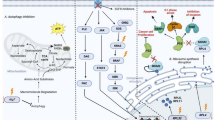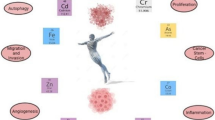Abstract
Due to the importance of the identification of chemotherapy outcome prognostic factors, we attempted to establish the potential of oxidative stress/DNA damage parameters such as prognostic markers. The aim of the study was to determine whether platinum derivative-based chemotherapy in cancer patients (n = 66) is responsible for systemic oxidatively damaged DNA and whether damage biomarkers, such as 8-oxo-7,8-dihydro-2′-deoxyguanosine (8-oxo-dG) and the modified base 8-oxo-7,8-dihydroguanine (8-oxo-Gua), in urine and DNA may be used as a prognostic factor for the outcome of chemotherapy. All the aforementioned modifications were analyzed using techniques involving high-performance liquid chromatography/electrochemical detection (HPLC/EC) or HPLC/gas chromatography–mass spectrometry (GC–MS). Among all the analyzed parameters, the significantly decreased levels of 8-oxo-Gua in urine collected from a subgroup of patients 24 h after the first infusion of the drug, as compared with the baseline levels, correlated with a significantly longer overall survival (OS) (60 months after therapy) than in the subgroup without any decrease of this parameter after therapy (median OS = 24 months, p = 0.007). Moreover, a significantly longer OS was also observed in a group with increased urine levels of 8-oxo-dG after chemotherapy (38.6 vs. 20.5 months, p = 0.03). The results of our study suggest that patients with decreased 8-oxo-Gua levels and increased 8-oxo-dG levels in urine 24 h after the first dose should be considered as better responders to the administered chemotherapy, with a lower risk of death. The conclusion may permit the use of these parameters as markers for predicting the clinical outcome of platinum derivative-based chemotherapy.


Similar content being viewed by others
References
Dizdaroglu M. Oxidatively induced DNA damage: mechanisms, repair and disease. Cancer Lett. 2012;327:26–47.
Wiseman H, Halliwell B. Damage to DNA by reactive oxygen and nitrogen species: role in inflammatory disease and progression to cancer. Biochem J. 1996;313:17–29.
Cho WC, Kwan CK, Yau S, So PP, Poon PC, Au JS. The role of inflammation in the pathogenesis of lung cancer. Expert Opin Ther Targets. 2011;15:1127–37.
Nediani C, Raimondi L, Borchi E, Cerbai E. Nitric oxide/reactive oxygen species generation and nitroso/redox imbalance in heart failure: from molecular mechanisms to therapeutic implications. Antioxid Redox Signal. 2011;14:289–331.
Cunningham RP. DNA repair: caretakers of the genome? Curr Biol. 1997;7:576–9.
Xu DD, Lam HM, Hoeven R, Xu CB, Leung AW, Cho WC. Photodynamic therapy induced cell death of hormone insensitive prostate cancer PC-3 cells with autophagic characteristics. Photodiagnosis Photodyn Ther. 2013;10:278–87.
Cooke MS, Olinski R, Evans MD. Does measurement of oxidative damage to DNA have clinical significance? Clin Chim Acta. 2006;365:30–49.
Noelker C, Hampel H, Dodel R. Blood-based protein biomarkers for diagnosis and classification of neurodegenerative diseases: current progress and clinical potential. Mol Diagn Ther. 2011;15:83–102.
Roszkowski K, Jozwicki W, Blaszczyk P, Mucha-Malecka A, Siomek A. Oxidative damage DNA: 8-oxoGua and 8-oxodG as molecular markers of cancer. Med Sci Monit. 2011;17:329–33.
Li N, Tan W, Li J, Li P, Lee S, Wang Y, et al. Glucose metabolism in breast cancer and its implication in cancer therapy. Int J Clin Med. 2011;2:110–28.
Cho WC. Nasopharyngeal carcinoma: molecular biomarker discovery and progress. Mol Cancer. 2007;6:1–9.
Sinhk SK, Szulik MW, Ganguly M, Khutsishvili I, Stone MP, Marky LA, et al. Characterization of DNA with an 8-oxoguanine modification. Nucleic Acids Res. 2011;39:6789–801.
Cooke MS, Evans MD, Dove R, Rozalski R, Gackowski D, Siomek A, Lunec J, Olinski R. DNA repair is responsible for the presence of oxidatively damaged DNA lesions in urine. Mutat Res. 2005;574:58–66.
Evans MD, Saparbaev M, Cooke MS. DNA repair and the origins of urinary oxidized 2′-deoxyribonucleosides. Mutagenesis. 2010;25:433–42.
Havelka AM, Berndtsson M, Olofsson MH, Shoshan MC, Linder S. Mechanisms of action of DNA-damaging anticancer drugs in treatment of carcinomas: Is acute apoptosis an “off-target” effect? Mini Rev Med Chem. 2007;7:1035–9.
Goncalves MS, Silveira AF, Teixeira AR, Hyppolito MA. Mechanisms of cisplatin ototoxicity: theoretical review. J Laryngol Otol. 2013;7:1–6.
Weijl NI, Hopman GD, Wipkink-Bakker A, Lentjes EG, Berger HM, Cleton FJ, et al. Cisplatin combination chemotherapy induces a fall in plasma antioxidants of cancer patients. Ann Oncol. 1998;9:1331–7.
Roszkowski K, Olinski R. Urinary 8-oxoguanine as a predictor of survival in patients undergoing radiotherapy. Cancer Epidemiol Biomarkers Prev. 2012;21:629–34.
Siomek A, Tujakowski J, Gackowski D, Rozalski R, Foksinski M, Dziaman T, et al. Severe oxidatively damaged DNA after cisplatin treatment of cancer patients. Int J Cancer. 2006;119:2228–30.
Ravanat JL, Guicherd P, Tuce Z, Cadet J. Simultaneous determination of five oxidative DNA lesions in human urine. Chem Res Toxicol. 1999;12:802–8.
Siomek A, Gackowski D, Rozalski R, Dziaman T, Szpila A, Guz J, et al. Higher leukocyte 8-oxo-7,8-dihydro-2-deoxyguanosine and lower plasma ascorbate in aging humans? Antioxid Redox Signal. 2007;9:143–50.
Foksinski M, Rozalski R, Guz J, Ruszkowska B, Sztukowska P, Piwowarski M, et al. Urinary excretion of DNA repair products correlates with metabolic rates as well as with maximum life spans of different mammalian species. Free Radic Biol Med. 2004;37(9):1449–54.
Poulsen HE, Loft S, Prieme H, Vistisen K, Lykkesfeldt J, Nyyssonen K, et al. Oxidative DNA damage in vivo: relationship to age, plasma antioxidants, drug metabolism, glutathione-S-transferase activity and urinary creatinine excretion. Free Rad Res. 1998;29(6):565–71.
Weijl NI, Elsendoorn TJ, Lentjes EG, Hopman GD, Wipkink-Bakker A, Zwinderman AH, et al. Supplementation with antioxidant micronutrients and chemotherapy-induced toxicity in cancer patients treated with cisplatin-based chemotherapy: a randomised, double-blind, placebo-controlled study. Eur J Cancer. 2004;40:1713–23.
Zamble DB, Lippard SJ. Cisplatin and DNA repair in cancer chemotherapy. Trends Biochem Sci. 1995;20:435–9.
Kyrtopoulos SA. Variability in DNA repair and individual susceptibility to genotoxins. Clin Chem. 1995;41:1848–53.
Strauss B, Hanawalt P, Swenberg J. Risk assessment in environmental carcinogenesis. An American Association for Cancer Research special conference in cancer research cosponsored by the Environmental Mutagen Society. Cancer Res. 1994;54:5493–6.
Sherman-Baust CA, Becker KG, Wood Iii WH, Zhang Y, Morin PJ. Gene expression and pathway analysis of ovarian cancer cells selected for resistance to cisplatin, paclitaxel, or doxorubicin. J Ovarian Res. 2011;4(1):21. doi:10.1186/1757-2215-4-21.
Srivastava AN, Gupta A, Srivastava S, Natu SM, Mittal B, Negi MP, Prasad R. Cisplatin combination chemotherapy induces oxidative stress in advance non small cell lung cancer patients. Asian Pac J Cancer Prev. 2010;11(2):465–71.
Dziaman T, Banaszkiewicz Z, Roszkowski K, Gackowski D, Wisniewska E, Rozalski R, et al. 8-Oxo-7,8-dihydroguanine and uric acid as efficient predictors of survival in colon cancer patients. Int J Cancer. 2013;134:376–83.
Loft S, Danielsen P, Lohr M, Jantzen K, Hemmingsen JG, Roursgaard M, et al. Urinary excretion of 8-oxo-7,8-dihydroguanine as biomarker of oxidative damage to DNA. Arch Biochem Biophys. 2012;518:142–50.
Kuznetsov NA, Koval VV, Fedorova OS. Mechanism of recognition and repair of damaged DNA by human 8-oxoguanine DNA glycosylase hOGG1. Biochemistry (Mosc). 2011;76:118–30.
Afzal S, Jensen SA, Sorensen JB, Henriksen T, Weimann A, Poulsen HE. Oxidative damage to guanine nucleosides following combination chemotherapy with 5-fluorouracil and oxaliplatin. Cancer Chemother Pharmacol. 2012;69:301–7.
Erhola M, Toyokuni S, Okada K, Tanaka T, Hiai H, Ochi H, et al. Biomarker evidence of DNA oxidation in lung cancer patients: association of urinary 8-hydroxy-2′-deoxyguanosine excretion with radiotherapy, chemotherapy, and response to treatment. FEBS Lett. 1997;409:287–91.
Poulsen HE, Nadal LL, Broedbaek K, Nielsen PE, Weimann A. Detection and interpretation of 8-oxodG and 8-oxoGua in urine, plasma and cerebrospinal fluid. Biochim Biophys Acta. 2014;1840:801–8.
Gupta A, Srivastava S, Prasad R, Natu SM, Mittal B, Negi MP, et al. Oxidative stress in non-small cell lung cancer patients after chemotherapy: association with treatment response. Respirology. 2010;15:349–56.
Li X, Xu H, Xu C, Lin M, Song X, Yi F, et al. The yin-yang of DNA damage response: roles in tumorigenesis and cellular senescence. Int J Mol Sci. 2013;14:2431–48.
Salehan MR, Morse HR. DNA damage repair and tolerance: a role in chemotherapeutic drug resistance. Br J Biomed Sci. 2013;70:31–40.
Collins AR, Cadet J, Moller L, Poulsen HE, Vina J. Are we sure we know how to measure 8-oxo-7,8-dihydroguanine in DNA from human cells? Arch Biochem Biophys. 2004;423:57–65.
Siomek A, Gackowski D, Rozalski R, Dziaman T, Szpila A, Guz J, et al. Higher leukocyte 8-oxo-7,8-dihydro-2′-deoxyguanosine and lower plasma ascorbate in aging humans? Antioxid Redox Signal. 2007;9:143–50.
Acknowledgments
I would like to thank Professor Ryszard Olinski, Department of Clinical Biochemistry, Collegium Medicum, Nicolaus Copernicus University, Bydgoszcz, PL for the inspiration to perform this work and his making possible laboratory investigations. I would like to acknowledge the contributions of Rafal Rozalski and Daniel Gackowski to this study.
Conflicts of interest
The authors have no conflicts of interest that are directly relevant to the content of this article.
Author information
Authors and Affiliations
Corresponding author
Rights and permissions
About this article
Cite this article
Roszkowski, K., Filipiak, J., Wisniewska, M. et al. Potential survival markers in cancer patients undergoing chemotherapy. Clin Exp Med 15, 381–387 (2015). https://doi.org/10.1007/s10238-014-0313-6
Received:
Accepted:
Published:
Issue Date:
DOI: https://doi.org/10.1007/s10238-014-0313-6




